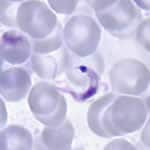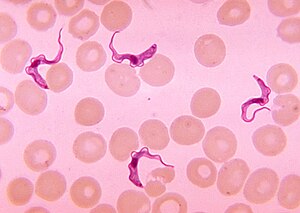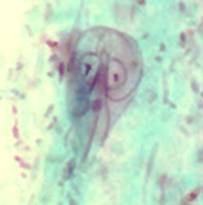Patient comes into the clinic with extreme constipation and shortness of breath and swelling in the legs. Should you ask for a blood smear to diagnose the patient?
No, this would be considered an inactive infection so you won't be able to see anything on blood smear. Use serology instead This is what it would look like
This is what it would look like
A 14-year-old girl presents to the clinic with the complaint of fever, headache, and muscle ache for the last two days. She also complains of malaise and pain in her joints. She just returned from a camping trip to Delaware. Her past medical history is insignificant. She denies any recent contact with a sick person. Her temperature is 101.0° F (38.3° C), pulse is 87/min, respirations are 17/min and blood pressure is 120/78 mm Hg. On physical examination, there is a 3-inch, red, erythematous, round rash with central clearing on the right leg as shown in the photograph. Antibodies against Proteus vulgaris OX-19 are absent. Which of the following is the most likely cause of her symptoms? What organism must have passed it to her?
The erythematous, round rash with central clearing lesion seen in this patient is erythema migrans. Its presence along with a history of camping in endemic regions of Lyme disease especially in the Northeast regions such as Connecticut, Delaware, New York, New Jersey is very highly suggestive of Lyme disease, which is caused by a spirochete, Borrelia burgdorferi.
A deer tick must have passed it to her?
What are the three symptoms that are caused by Toxoplasma gondii congenitally?
Chorioretinitis
Intracranial calcifications
Hydrocephalus
What are the 5 side effects of macrolides?
- Motility
- Arrhythmia (prolonged QT)
- Cholestatic hepatitis + Cyt P450
- Rash
- eOsinophilia
A group of friends went to fast-food restaurant for a college reunion party. Within the next few days, all of them complained of bloody diarrhea, fatigue, and confusion. Physical exam revealed neurological deficits. Laboratory tests show anemia, thrombocytopenia, and uremia. Lactate dehydrogenase (LDH) is raised while haptoglobin is decreased. Peripheral blood smears show fragmented RBCs. Coombs tests are negative. Which of the following is the responsible organism?
Correct answer B: Patients are having Hemolytic uremic syndrome (HUS). It is a disease characterized by hemolytic anemia, acute kidney failure (uremia) and thrombocytopenia. It is caused by E. coli O157:H7.
E. coli produces verotoxin (also called Shiga-like toxin). It inactivates 60S ribosomal units and halts protein synthesis. Bloody diarrhea typically follows. HUS develops about 5–10 days after onset of diarrhea, with oliguria, hematuria, kidney failure, thrombocytopenia, and destruction of red blood cells (microangiopathic hemolytic anemia). The destruction of RBCs lead to increased LDH levels and decreased haptoglobin. In some cases, there are prominent neurologic changes.
Patient presents with recurring fevers after having been to Gambia for a school field trip. This is seen on her blood smear:
What sickness does she have and what stage are they in?
African Sleeping Sickness due to Trypanosoma bruceii and these are trypomastigotes in the blood.
In a healthy individual that's been infected with Bartonella henselae, what kinds of clinical features would you see? What stain would help you visualize the organism?
Regional lymph nodes (axilla particularly) would be inflamed
Warthrin Starry stain (silver)
A man who has just come back from Connecticut comes into the clinic with irregular fevers and jaundice. What disease might he have and what will you see on a blood smear? BONUS: What disease is also found in this area of the US
He has Babesiosis and you will see a maltese cross appearance on RBC's
BONUS: Borrelia is also from NE US
A 25-year-old medical student is doing an international health elective in the Amazon River basin studying tropical disease epidemiology. As part of his pre-trip preparation, he wants to be protected from malaria and is researching options for prophylaxis. Which of the following agents should be avoided for malarial prophylaxis in this patient?
Chloroquine because the Amazon River contains chloroquine-resistant malaria.
It works in ME, CA, and Caribbean
A 23-year-old woman presents to the clinic for her first prenatal appointment with an unusual fatigue and pain in her perineum for the past 8 days. She does not have any significant past medical history and claims of unprotected intercourse only with her husband. She had an allergic reaction to amoxicillin two years ago. A vaginal speculum exam reveals a clean, ulcerated genital lesion, which is tender and non-exudative. No lymphadenopathy is detected. A rapid plasma reagin (RPR) test reveals a titer of 1:64 and the fluorescent treponemal antibody absorption (FTA- abs) is positive. What is the next best step in the management of this patient?
- A.
Parenteral Ceftriaxone 1 g for 10 days
- B.
Penicillin desensitization, then benzathine penicillin G 2.4 million units once intramuscular
- C.
Tetracycline 500 mg orally 4 times daily for a week
- D.
Doxycycline 100 mg twice daily for 14 days
- E.
Hold treatment until delivery
Correct answer B: This patient has primary syphilis which is evident by her symptoms and laboratory results. A genital ulcer, positive FTA and a positive RPR with a high titer are clues to this diagnosis. Parenteral benzylpenicillin is the only recommended treatment for pregnant women. If a patient has a well-documented allergic reaction to penicillin, as this patient, the recommendation is desensitization to penicillin until a full dose is tolerated. Women should receive penicillin according to the stage of syphilis, although some specialists suggest that women who present in the third trimester with early syphilis should receive 2 doses rather than 1.

What treatment can you use if you find this organism in the stool O&P
Metronidazole
A 52-year-old man comes to the public health clinic because of shortness of breath, fatigue, and swelling of both of his legs for the past 2 weeks. He recently immigrated from Bolivia to live with his daughter and her husband. He has not yet found work and is financially stressed. Physical examination of the patient shows bilateral peripheral edema, a distended abdomen, and hepatomegaly. Cardiac ultrasound shows dilatation and hypertrophy of all four chambers. Myocardial biopsy shows inflammation with eosinophilic infiltrate. Which of the following is the most likely cause of the patient's condition? How exactly is this disease transmitted?
The patient has Chagas disease which is caused by Trypanosoma cruzi.
It is passed through the Reduiit bug (kissing bug) which defecates near the mouth or the eyes while people are asleep -- so technically not a bite!
A 30-year-old woman comes to the clinic complaining of shaking chills, fever and headache for the last 3 days. She says that she recently returned from a trip to India where she was visiting family. There is no history of loss of consciousness or respiratory distress. Vitals noted are temperature of 38.9℃ (102.0℉), respiratory rate of 19/min, blood pressure of 120/80 mm Hg, rapid and thready pulse 94/min could be palpated. On general examination she looks pale and there is presence of jaundice in her upper sclerae. Laboratory findings are as follows:
Hct30%Total bilirubin 2.6 mg/dLDirect bilirubin 0.3 mg/dL
Peripheral smear is shown in the exhibit. What is the most deadly complication of this condition?
- A.
Heart block
- B.
Facial paralysis
- C.
Cerebral edema
- D.
Aplastic crisis
- E.
Rheumatoid arthritis
Malaria classically presents with paroxysm of fever with chills and rigors. The malarial paroxysm coincides with release of merozoites from ruptured erythrocytes. Headache, jaundice, anemia, splenomegaly and hepatomegaly are other signs and symptoms of malaria. Additionally, unconjugated bilirubin will be elevated as the red blood cells rupture during the parasite’s maturation process.
Unlike other forms, P. falciparum causes microvascular complication due to obstruction. Infected red blood cells adhere to endothelial cells. Ischaemia classically develops in the brain, kidneys, lungs and GI tract. It can be fatal if untreated. Fever spikes intermittently at an interval of 48 hours. Patient with cerebral edema can present with irritability to seizures to coma. Acute respiratory distress syndrome, diarrhoea, shock like syndrome (Algid malaria), thrombocytopenia, hypoglycemia, lactic acidosis are other complications. Renal insufficiency may result from volume depletion, vascular obstruction by parasitized erythrocytes.
A 23-year-old woman comes to the emergency department because of headache, fever, rash, and vomiting for the past 2 days. She also noticed that she has been extremely sensitive to light. The patient states she has never experienced this combination of symptoms before, and has not recently traveled outside of the country or has any recent sick contacts. Upon further history, patient revealed that she had recently gone camping with a few friends. Physical examination of the patient shows a petechial rash on the extremities (including palms of hands and soles of the feet) and chest, as well as conjunctivitis present bilaterally. Based on the patient's presentation, what would be the best treatment and what is the mechanism of action?
Doxycycline is the best treatment and it prevents elongation of the peptide chain by binding to the 30S ribosome.
A 15 year old boy comes in to clinic with pain in his right ear. He is on his school swim team and spends about 2 hours per day in the pool. Along with the pain in his ear, he has watery drainage coming from the ear canal. On exam his vital signs are normal, and he appears healthy, but his left external ear looks quite red and there is copious watery, slightly green drainage coming from the ear. The organism mostly likely causing this is:
Pseudomonas aeruginosa
Otitis externa is common with this organism

The patient has just come back from sub-Saharan Africa and is febrile with his spleen palpable below the costal margin. What is shown in this blood smear? Which parasite stage is depicted?
The patient has malaria. A schizont is a mature parasite cell form that develops inside the erythrocyte in the form of multiple merozoites (replicative phase). The presence of hemozoin (digested hemoglobin) is characteristic. Mature schizonts culminate in the rupture of the red blood cell releasing thousands of merozoites into the bloodstream.
A 50-year-old man presents to the emergency room for prolonged fever, shortness of breath, and chest pain. He is admitted for heart failure and suspected endocarditis. A cardiac echocardiogram shows vegetation on the valves. The initial blood cultures are negative. Upon further investigation, he works at a leather supplier and often visits farms to evaluate the cattle. He is treated for a suspected zoonotic endocarditis with doxycycline and hydrochloroquine. What was he diagnosed with and what organism transmits it? What is a disadvantage that the organism has?
This is Q fever transmitted from Coxiella burnetti and the disadvantage it has is that it's an obligate intracellular organism which means it cannot survive outside of the host's cells.
In this disease, sporozoites attach to the intestinal wall and cause diarrhea and small intestine damage. In what patients will you see severe diarrhea? What organism causes these symptoms? What treatment will you prescribe?
Immunocompromised HIV patients will have severe diarrhea, this is a case of cryptosporidium. Nitazoxanide is frequently prescribed for this as well as emphasizing prevention for campers and people who work with animals.
A 51-year-old Caucasian man is referred to the office for the evaluation of fever of undetermined origin. His medical history is only relevant to a business trip to Sudan 1 month ago. Upon medical interrogation, the patient complains that his fevers are alternating, and usually last for a few hours and then reappear 3 days later. Physical exam shows hepatosplenomegaly. His temperature is 40.1°C (104.1°F), pulse is 100/min, respirations are 16/min, blood pressure is 100/60 mmHg. He is given the appropriate treatment, but after a couple days he experiences headaches and tinnitus. Why?
He was probably prescribed quinidine. Quinidine has side effects of headaches and tinnitus.
When are fevers highest? What are the endogenous cytokines that are released to cause an increase in body temperature?
IL1, IL6, TNF alpha, INF, CNF
You receive a urine culture report from the laboratory on a 45 year old patient who is a quadriplegic with an indwelling urinary tract catheter. What organism is responsible?
Pseudomonas aeruginosa
What are two diseases that are caused by the Aedes mosquito? List three characteristic symptoms of each.
Dengue Fever: breakbone fever, thrombocytopenia, renal failure, septic shock, severe abdominal pain, rash
Yellow Fever: jaundice, backache, bloody diarrhea, abdominal pain with vomiting, renal failure
A 44-year-old native Nigerian who has lived in the USA for 10 years returned to visit his family in Africa and now presents with a history of shaking chills, followed by high fever and then profuse sweating. He states that this is the most severe case of malaria he has ever had. His blood smear shows malaria organisms consistent with Plasmodium falciparum. Which of the following statements is false regarding P. falciparum?
A. His symptoms are more severe this time because he has lost some of the immunity that comes with frequent recurrences of malaria
B. Taking appropriate prophylactic medication has an 80-90% chance of preventing P. falciparum malaria
C. P. falciparum causes organ damage in the brain, lungs, and kidneys because of adhesion of infected red cells to the endothelium of the capillaries which impairs the microcirculation to these organs
D. P. falciparum gametocytes are ameboid shaped
E. Plasmodium falciparum has the highest mortality rate of the four malaria species
D.
P. falciparum gametocytes are not ameboid shaped, they are banana shaped

A 23 y/o male comes into the clinic with a fever and disfiguring ulcers. Many questions later, he reveals that he has just come back from Brazil and he thinks he was bitten by something while he was there. What drug is recommended and how is it administered?
Stibogluconate, intravenously for Cutaneous Leishmaniasis
What are 4 diseases that present with fever and splenomegaly?
Malaria
Visceral Leishmaniasis
Brucellosis
Typhoid